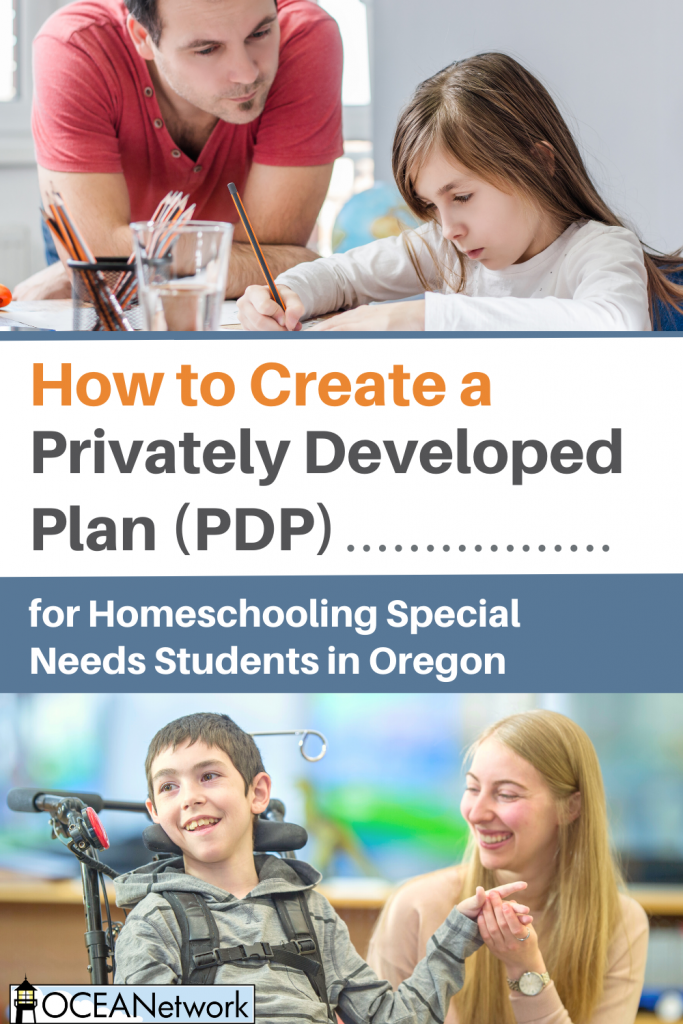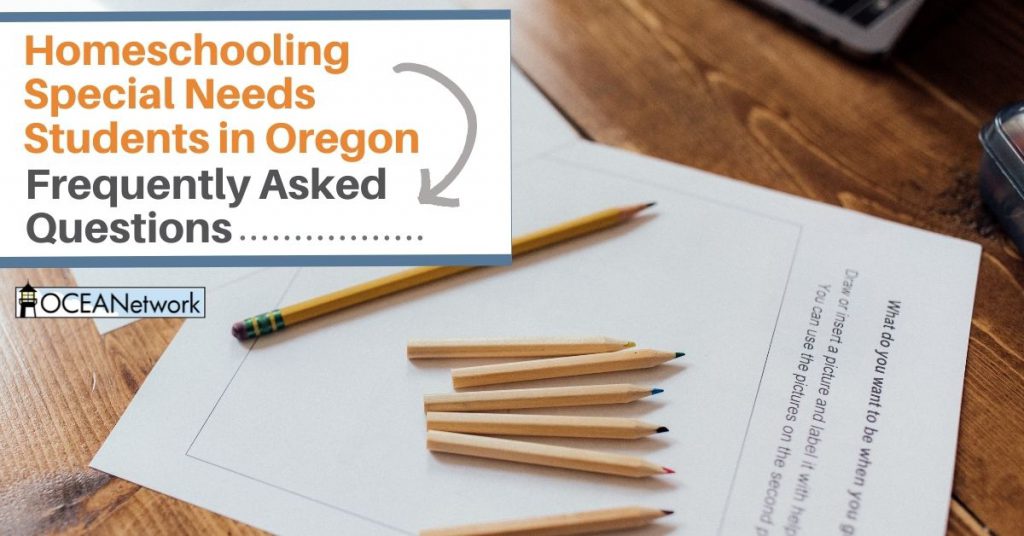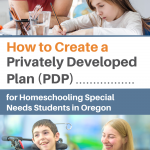A Privately Developed Plan (PDP) is an evaluation option for special needs students that is specific to Oregon. Members of the OCEANetwork Freedom Watch Team had a hand in helping craft the PDP homeschool laws, with the intent of providing a simple, flexible, and low-cost way for parents to appropriately evaluate the progress of their special needs student.

What is Required in a Privately Developed Plan?
Here is what the law requires for a PDP:
- It is developed by a team including the parent and one or more private service providers.
- The plan includes individual educational goals for the student, established at the beginning of the school year for required testing years (grades 3, 5, 8, and 10)
- The PDP indicates how “satisfactory educational progress” will be determined
- “Satisfactory educational progress” means educational progress across academic and/or developmental areas appropriate to the child’s age and abilities.
- At the end of evaluation years, the provider submits a statement indicating whether satisfactory educational progress has been met, providing a copy for the parents.
- Not all goals must have been met in order to determine that the student is making satisfactory progress.
The homeschool laws were kept intentionally general to allow for greater flexibility and simplicity to benefit homeschool families. However, if you are creating a PDP for the first time, or are considering being a Private Service Provider for a homeschool family’s PDP, here’s what you should do:
- Join HSLDA
- Get a Diagnosis
- Find a Qualified Private Service Provider
- Design a Privately Developed Plan
- Complete Progress Evaluations
Join HSLDA
We recommend that all families using a PDP with one or more of their children join HSLDA, especially those in the Lane or Linn-Benton-Lincoln ESD. HSLDA offers legal support as well as access to educational consultants who can answer questions about diagnosis, curriculum, therapies, and more.
Note: OCEANetwork Supporting Families receive $15 off an annual HSLDA membership! Find out more here.
Get a Diagnosis
If your student does not already have an official diagnosis for their disability, you may be required to get that diagnosis and provide it to the ESD upon request. This diagnosis could come from a doctor, a learning specialist, or the public school.
If you need help finding someone who can provide a diagnosis, consider talking with professionals you already work with or parents with students that have similar disabilities and see who they recommend. You could also join our Homeschooling in Oregon Facebook page and ask the families there who they suggest.
Find a Qualified Service Provider
A service provider for a Privately Developed Plan is an individual who is able to understand, evaluate, and help set goals for your student and provide evaluations on whether they are making progress. For example, it could be a professional your child is already working with or someone who has experience educating special needs students. The provider must not be a relative of the student.
While homeschool law doesn’t go into great detail about what a PDP service provider should look like, it is in the best interest of your student and your homeschool to make sure you choose someone who is credible for this position.
If you are having trouble finding a provider to help you craft your PDP, here are some ideas to consider:
- Ask current therapists and professionals your child has worked with.
- Contact associations and organizations relating to their disabilities and ask for suggestions.
- Contact SPED, a non-profit organization that serves the special needs homeschool community worldwide, to ask for assistance finding a provider.
- Reach out to the HSLDA Special Needs team to ask for ideas on locating a provider. Their HSLDA Compassion program may also provide financial help for families in need, such as for funding diagnosis and provider services.
- Contact parents who have experience with the same or similar special needs and see if they can recommend someone who may make a good service provider. The Homeschooling in Oregon Facebook page may be a good place to ask as well.
There will be instances where the person you consider as a service provider will not have experience with PDPs and will want more information about what’s involved. Share this page with them for reference and refer them to OAR 581-021-0029. It’s also helpful to let them know the following:
- They will meet with you for an initial assessment of the child’s current level of functioning and set academic and/or developmental goals.
- They may also provide/suggest necessary therapies, recommend resources, etc.
- At the end of the year, they meet with you again briefly to help evaluate the student based on the goals that were set.
- They must sign their name on evaluations for 3rd, 5th, 8th, and 10th grades indicating whether the student has made satisfactory progress, and then provide you with a copy of those evaluations.
- The service provider does not have to reside in Oregon
Remember, while it’s important for your service provider to be qualified for this role, the process need not be overly time-consuming, complex, or expensive.
Design a Privately Developed Plan
A Privately Developed Plan (PDP) is an evaluation option provided in Oregon for homeschool students with qualified disabilities. Parents choose one or more private service providers to help them put together an educational plan for their child at the beginning of the school year (for required testing years) and provide evaluations at the end of those years that satisfy Oregon homeschool laws.
The PDP is established at the beginning of the year and documents the initial evaluation, educational goals, and an explanation of how progress will be evaluated. Parents should keep the PDP on file for their student, but they do NOT send the PDP to the ESD or school district. Only parents and the service provider(s) they are working with need to see the PDP.
There is flexibility on what exactly the PDP looks like. Here is what it must include:
- Initial evaluation. The private service provider evaluates the student’s current academic and developmental abilities to provide a baseline for determining progress.
- Goals for your student. These goals include academic and/or development goals appropriate to the child’s age and abilities, and help you plan your course of study.
- A plan for evaluating progress. After stating the educational goals for the student, the PDP must state how “satisfactory educational progress” will be determined. This statement should include the method that will be used for evaluation.
How do you set goals and make evaluations? You can do whatever makes the most sense to you and your private service provider(s) given the needs and abilities of your student. This could include demonstration of certain skills, observing and noting progress in specified areas over time, building a portfolio of work, using tests of various kinds, written work or oral interviews, completion of certain curriculum milestones, etc.
Complete Progress Evaluations
At the end of grades 3, 5, 8, and 10, the private service provider evaluates the student based on the goals that were set in the PDP to determine if they made “satisfactory educational progress.”
“Satisfactory educational progress” is defined in the rules to mean “educational progress across academic and/or developmental areas appropriate to the child’s age and abilities.” The rules state that the student does not need to complete all the goals in order to determine that he or she has made satisfactory educational progress.
The private service provider then signs their name on a statement that “______________ is making satisfactory educational progress as defined in OAR 581-021-0029.” The parent keeps a copy of this statement on hand to send to the ESD if they request it. (Note that the ESD may have requested that you report in grades 3, 5, 8 and 10 when they responded to your letter of intent to home educate.)
Tips on Creating a PDP
The information that is required in a PDP is fairly simple: initial evaluation, goals, and statement of how progress will be determined. Here are some additional tips to keep in mind:
- Depending on the student’s abilities, goals can include the basic academic subjects that are included in standardized testing (math and language arts)
- Goals can also be developmental, such as life skills, personal care, etc.
- Goals may also include participation in certain therapies, services, or other special instruction
- If you are using a particular curriculum, you can set goals that include completion of certain milestones in that curriculum.
- Make goals attainable for your student, setting objectives that you believe they can obtain given time and ability constraints.
- To make evaluation time easier, consider setting goals that are measurable.
- Remember, you are NOT sharing the PDP plan/goals with the ESD. It is a tool for you and your private service provider to evaluate progress.
For more ideas on crafting goals for a special needs educational plan, see this guide at SPED and this one at HSLDA. Note that they use the terms like IEP, SEP, etc. in a general way, not specific to public school plans. You can glean ideas there that are helpful for you and your private service provider in developing your PDP.
Have More Questions?
Find answers to your questions on our FAQ for Homeschooling Special Needs in Oregon page.


I would like assistance if possible in finding a person to help me find write a PDP. I need a baseline. I have an IEP that is due for renewal this month. I need to be able to measure progress. I haven’t been able to connect with other parents that have done this
Hi Maria!
Finding a PDP service provide can be challenging. However, you may be interested to hear that our OCEANetwork Supporting Members have exclusive access to PDP provider services (for an extra fee) with SPED Homeschooling. It’s worth looking into! We’re excited to offer this benefit to our supporters this year for the first time. >> https://oceanetwork.org/supporting-membership/
Does a child with a PDP get evaluated every single year? Or only at the end of grades 3, 5, 8, and 10? Does the PDP get reevaluated and changed every year? Or does reevaluation of the PDP happen at the end of grades 3, 5, 8, 10?
The law only requires an evaluation at the end of grades 3, 5, 8, and 10. So at the beginning of each of those years, the parent and PDP provider do the initial assessment and set goals. At the end of those years, the provider evaluates the students against those goals and provides a written statement on whether they have made satisfactory educational progress. Some families choose to do PDP goals and evaluations every year. However, they are only required to do so at the end of grades 3, 5, 8, and 10.